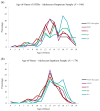Examining the Course of Suicidal and Nonsuicidal Self-Injurious Thoughts and Behaviors in Outpatient and Inpatient Adolescents
- PMID: 27761783
- PMCID: PMC5397367
- DOI: 10.1007/s10802-016-0214-0
Examining the Course of Suicidal and Nonsuicidal Self-Injurious Thoughts and Behaviors in Outpatient and Inpatient Adolescents
Abstract
Suicidal and nonsuicidal self-injurious thoughts and behaviors (SITBs) among youth are major public health concerns. Although a growing body of research has focused on the complex association between nonsuicidal and suicidal self-injury, the temporal relationship between these two classes of behaviors is unclear. The current study addresses this empirical gap by examining the course of SITBs in adolescents receiving outpatient (N = 106; 82.1 % female) and inpatient (N = 174; 75.9 % female) treatment. SITBs (co-occurrence, age-of-onset, and time lag between SITBs) and major psychiatric disorders were assessed at a single time point with well-validated structured interviews. Adolescents in both clinical samples reported high co-occurrence of SITBs: most adolescents reported both lifetime nonsuicidal self-injury (NSSI) and suicidal thoughts. A similar temporal pattern of SITBs was reported in the two samples: thoughts of NSSI and suicide ideation had the earliest age-of-onset, followed by NSSI behaviors, suicide plans, and suicide attempts. However, the age-of-onset for each SITB was younger in the inpatient sample than in the outpatient sample. In terms of time lag between SITBs, suicide ideation occurred on average before initial engagement in NSSI, suggesting that pathways to NSSI and suicidal behavior may occur simultaneously rather than in succession from nonsuicidal to suicidal self-injury. Results also indicated that the time to transition between SITBs was relatively fast, and that a key period for intervention and prevention is within the first 6-12 months after the onset of suicidal thinking. Taken together, these findings have important implications for understanding the time-lagged relationship between nonsuicidal and suicidal self-injury.
Keywords: Adolescence; Nonsuicidal self-injury; Self-injury; Suicide; Suicide attempts.
Figures


References
-
- American Psychiatric Association. Diagnostic and statistical manual of mental disorders. 5. Washington, DC: American Psychiatric Association; 2013.
-
- Asarnow JR, Porta G, Spirito A, Emslie G, Clarke G, Wagner KD, et al. Suicide attempts and nonsuicidal self-injury in the treatment of resistant depression in adolescents: findings from the TORDIA study. Journal of the American Academy of Child and Adolescent Psychiatry. 2011;50:772–781. - PMC - PubMed
MeSH terms
Grants and funding
LinkOut - more resources
Full Text Sources
Other Literature Sources
Medical
Miscellaneous

